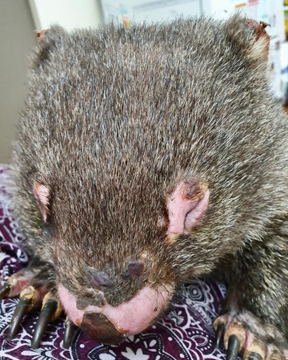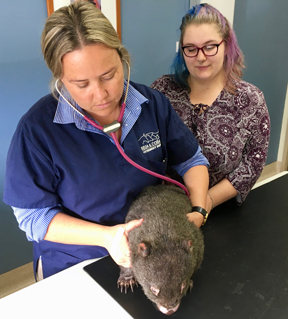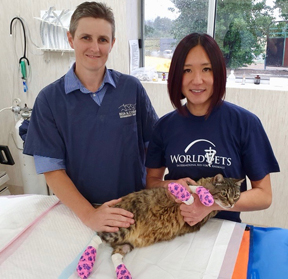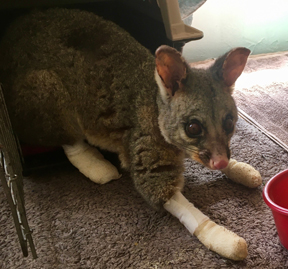
Bernie 288

VIN News Service photo by Ross Kelly
A wombat dubbed "Bernie," found at Myrtle Mountain in southern New South Wales, was treated at the Bega Veterinary Hospital for burns to his ears, which required removing some ear tissue. Bernie also had less serious burns on his face and near his paws.
Dr. Jane Woolacott and her family were hunkered down inside the Bega Veterinary Hospital, trying to figure out whether to stay put or evacuate all the animals.
It was Saturday, Jan. 4, and wildfires were bearing down on Bega, a dairy town in the state of New South Wales caught in one of Australia's worst-ever natural disasters.
The day had turned almost dark as night, and the sky a deep, hellish red. It was 111 degrees Fahrenheit (44 degrees Celsius), and the air outside filled with thick smoke and ash.
Woolacott, her husband Adam and their three young children had sought refuge at the veterinary clinic where she works, on Ridge Street. They had just evacuated their home, about five minutes' drive away, Adam Woolacott leaving garden sprinklers running on its roof as a defense measure.
Initially, the clinic seemed like a safe place to go, but Woolacott, a veterinarian with 18 years' experience, started having doubts as the day wore on.
"It was getting smokier and smokier and the wind was picking up," she recounted a few weeks later while giving the VIN News Service a tour of the devastation.
At 2:52 p.m., Woolacott received a text message from the NSW Rural Fire Service recommending evacuation. The decision to flee was still up to her and her husband. "It was really scary, especially with the kids there," she said. "You're pretty unsure of how safe you're going to be because you don't really know where the fire is going to go."
The fire brigade was telling residents that a new southerly wind could blow wildfire through northern Bega, where the veterinary clinic was located. Around the same time, three or four fire trucks showed up outside the clinic, bracing for incoming flames. "That was the point when we decided to evacuate," she said.
Some of the animals in the clinic already had been shifted by trailer to a stockyard in another part of town, as a precautionary measure, by the Animal Welfare League, a charity. Still, Woolacott and her family had to bundle the remaining cargo — four sick dogs and cats, including a canine with a fractured femur, eight puppies and two other dogs — into their cars. They retreated to Adam Woolacott's physiotherapy practice in Bega's town center and waited.
Hundreds of veterinary practices experience hardship
As fate would have it, fire never touched the Bega Veterinary Hospital that day, nor did it touch the Woolacott family home. Many others business and home owners around Bega and elsewhere in Australia aren't as fortunate.
 The catastrophic wildfires, fueled by a three-year drought, have so far killed at least 33 people and destroyed more than 2,500 homes, according to local authorities. Around 25 million acres of bushland has been burned — an area the size of the U.S. state of Virginia — with most of the damage occurring in New South Wales and Victoria states. An ecologist from the University of Sydney, Chris Dickman, has estimated that more than a billion animals have perished, and there are fears for the future of dozens of threatened or endangered species, including the iconic koala.
The catastrophic wildfires, fueled by a three-year drought, have so far killed at least 33 people and destroyed more than 2,500 homes, according to local authorities. Around 25 million acres of bushland has been burned — an area the size of the U.S. state of Virginia — with most of the damage occurring in New South Wales and Victoria states. An ecologist from the University of Sydney, Chris Dickman, has estimated that more than a billion animals have perished, and there are fears for the future of dozens of threatened or endangered species, including the iconic koala.
The direct impact on Australia's veterinary community also has been profound. Across the country, about 100 clinics have suffered seriously, either by sustaining partial fire damage or being forced to shut their doors due to complications such as power loss, according to Dr. Julia Crawford, president of the Australian Veterinary Association. Another 250 veterinary practices have been impacted more moderately, she said. Australia has a total of 11,418 veterinary clinics, according to an AVA workforce survey conducted in 2016.
"These practices in the south coast get most of their income in the summer months, because that's when the tourists and the holidaymakers come, often to their holiday homes," Crawford told VIN News by telephone.
This year, vacationers have either fled or stayed away because of the fires, she said, sapping veterinarians' income. Crawford recalls talking to one practice owner who said they usually made at least a couple thousand dollars a day at this time of year. In the first 10 days of 2020, the practitioner had pulled in a total of AU$300 (US$206).
Part of the reason practices in fire zones are suffering financially is because they are treating for free pets of owners who have lost everything. "They know they can't afford to pay," Crawford said.
About 15 minutes' drive north of Bega Veterinary Hospital, Woolacott pointed to the charred and buckled remains of two destroyed properties situated near her parents' home. A woman and five of her grandchildren were trapped inside one of those houses, she said, rescued at the last minute from the burning building by a brave young firefighter.
Woolacott's parents' home shows battle scars: The front fence is partly blackened by fire that struck around New Year's; her mother and father stayed behind and successfully fought back the flames. Woolacott's mother sustained minor burns to her face and ears. Four pet cows, inherited by the couple when they bought the property about a decade ago, all survived. During the visit, Woolacott checked one of the cow's hooves for burn injuries.
A little further north up the Princes Highway, the Bega Veterinary Hospital's sister clinic in the town of Cobargo came off worse than the one in Bega. It wasn't burned, but fire knocked out its power supply for about 10 days, Woolacott said. The Cobargo branch still got off relatively lightly: Fire incinerated some buildings just three doors down. Blackened trees indicate the flames reached the clinic's back fence.
Of the 33 known people killed this wildfire season, five died in and around Cobargo. Some were known to Woolacott and her colleagues personally.
Treating cattle and wildlife a distressing challenge
Despite many suffering financial and personal hardships, veterinarians continue to work at the forefront of national relief efforts aimed at treating injured companion animals, livestock and wildlife. When it comes to wildlife, practitioners are being offered scant financial compensation, which is nothing new. Australian practices treat an average of five to 10 injured native animals every week, fires or not, usually without financial compensation, according to research published in 2018 in the Australian Veterinary Journal.
The AVA's Crawford said state land authorities are paying some veterinarians to assist in treating cattle. In Victoria specifically, a relatively small number are being paid by the government to treat wildlife, as authorities there have built more comprehensive response protocols in the wake of that state's deadly "black Saturday" wildfires in 2009. The coordination of wildlife treatment in New South Wales has been more haphazard.
Veterinarians at the Bega and Cobargo clinics have been seeing at least one wildlife case related to fire injury every day, Woolacott said, with the animals usually suffering painful burns to paws, tails or faces. On a recent day, two volunteers from the Wildlife Information, Rescue and Education Service, a wildlife charity, waited patiently in the lobby, each cradling an injured wombat. One wombat had been given the name Bernie.
Woolacott also has been spending the past few weeks with local land authorities assessing injured cattle. It's a harrowing task: Many of the beasts have had to be euthanized, typically with a bullet to the head. "It's been interesting work but it's also been pretty horrible," she said. "You don't become a vet to go out and shoot animals."
Bernie exam 288

VIN News Service photo by Ross Kelly
Dr. Jasmin Thomson (left) of Bega Veterinary Hospital does a follow-up exam on Bernie. Behind her is Jessica Groves of the Wildlife Information, Rescue and Education Service, a charity organization. Groves is helping to care for the wombat while he recovers.
One of the trickiest challenges veterinarians have been facing out in the field is assessing the severity of burns on livestock, usually from a distance because facilities have largely been destroyed by fire and approaching animals too closely can be dangerous or scare them away. A number of other factors also must be taken into consideration, including whether food, transportation and other resources are available to nurse an animal back to health, Dr. Peter Alexander, owner of the Bega and Cobargo clinics, explained to VIN News.
"The worst thing you can have is a veterinarian providing false hope to owners with burned animals," he said. "Serious clinical signs can continue to develop up to three weeks after the event and veterinarians don't want animals to suffer unnecessarily."
Alexander said a common injury found on cattle during wildfires is burns to the legs and feet. Those injuries can take weeks to develop to the point that the hoof completely detaches. When that happens, the animal needs to be killed to end its suffering. Unfortunately, the damage can't always be diagnosed early, meaning veterinarians are having to return regularly to properties to inspect cattle feet.
"In one case, we went out with a government guy and we shot between 25 and 30 of an owner's cows in front of him and his son," Alexander recalled.
Three days later, they had to shoot another 12, he said, "and it rolled on like that for three weeks. You've got to have people going back and going back and going back. And there needs to be emotional support for everyone involved. It's just horrific stuff."
Crawford said that tens of thousands of cows, sheep, horses and other livestock have died in the fires. Woolacott recalled about 150 cattle being shot in a single day, on a single property, near Bega.
Alexander said a key source of support for veterinarians dealing with the crisis has come from other veterinarians, many of whom have dropped into the Bega practice from around the country to lend a hand. "They can let you get some breathing space and catch up with things," he said.
'The koalas got smashed, the kangaroos didn't stand a chance'
Up and down the coast, the strain is being lightened by volunteers from non-governmental veterinarian organizations. One of the more prolific is Vets Beyond Borders, a Sydney-based group that has been liaising with the AVA on the so-called Australian Veterinary Emergency Response Team, or AVERT.
Vets Beyond Borders, which runs AVERT, recently put out a call for veterinarians and veterinary nurses to volunteer for relief efforts. They were inundated with hundreds of offers, from Australia and abroad, and have provided a list of volunteers to emergency authorities, who can contact them directly for deployment where needed, a spokesperson said via email.
The veterinarians in Bega and Cobargo have been getting help from another organization: the American charity World Vets, which is based in Gig Harbor, Washington. World Vets' efforts in Australia are headed by Dr. Ben Brown, an Australian who owns two practices in Sydney's northern beaches, and who once worked at the Bega Veterinary Clinic.
Brown has spent the past several weeks driving between Sydney and affected fire areas, delivering tens of thousands of dollars' worth of supplies to veterinary clinics and wildlife hospitals, including bandages, painkillers and antibiotics.
He said a recent bout of rain emboldened World Vets to start planning wildlife search-and-rescue missions deeper into the bush. He stressed that the work is still dangerous because of the risk of falling trees, meaning coordination with local fire brigades is still crucially important.
Dr. Woolacott and volunteer 288

VIN News Service photo by Ross Kelly
Dr. Jane Woolacott (left) of the Bega and Cobargo Veterinary Hospitals, accompanied by Dr. Tanya Soo Phillips, a volunteer with the U.S.-based organization World Vets, hold a pet cat whose paws were burned.
In many places, though, there isn't much wildlife left to treat because fire incinerated everything in its wake, Brown said. He estimates only 10% to 20% of wildlife in the worst-affected fire zones has survived. Certain species have fared better than others.
Brown said: "Wombats have extensive burrows underneath the ground and they were able to get away, and little wallabies can get down into wombat holes as well. But the koalas, of course, just got smashed. And the kangaroos, they really didn't stand a chance."
The most common injuries he's encountering? Burns are the most obvious, he said, followed by respiratory problems caused by smoke inhalation, such as secondary pneumonia. Many animals also are found to suffer from severe dehydration or malnourishment and have to be given fluids intravenously.
Among companion animals, Brown is dealing with gastroenteritis outbreaks and behavioral problems associated with evacuation procedures that see animals kept in strange places and fed irregular diets. "Cats in particular are becoming stressed, having been in carrier cages for long periods and developing urinary problems and things like that," he said.
Secondary problems for veterinarians and wildlife caretakers to consider are: Is there enough food and water in an affected area to support an animal's swift return to the wild? Is it safe to return animals to new habitats where they might be bullied by animals with an established hierarchy?
A call for caution, consideration, coordination
If anything good comes from the crisis, it's a recognition that more needs to be done to coordinate a more effective veterinary response to fires, especially for the treatment of wildlife, sources interviewed by VIN News agreed.
Each spoke of instances in which they saw relief efforts being poorly managed, or conducted in a dangerous manner.
Alexander recounted seeing one charity hand out basic supplies, such as water and food, without first assessing whether recipients really needed the help. "So the struggling local business actually selling the same stuff down the road just lost another genuine customer," he said.
Brown recalled instances in which small wildlife charities charged into the bush without coordinating with local veterinary practices and ended up inspecting ground already covered by another group.
Crawford said well-meaning volunteers also could be taking work from local veterinarians struggling for business, should they fail to contact those practices at the outset.
Even worse, she's been informed of serious medications — including, in one instance, a bag of saline with ketamine in it — falling into the hands of volunteer wildlife caregivers who have no idea how to administer the drugs correctly.
"For the veterinarians and those treating wildlife in particular, it's a bit scary because there isn't enough veterinary oversight," she said.
Crawford welcomed a recent move by Australia's federal government to provide AU$50 million (US$34 million) of funding for wildlife relief efforts and species mapping. She noted that the country currently has a federal emergency response plan for disease outbreaks but not for natural disasters such as wildfires. "In future, that will need to change," she said.
In the meantime, it is up to individual organizations to make sure they're doing things the right way.
Possum 288

VIN News Service photo by Ross Kelly
A brushtail possum given the name Hagrid was found in Cobargo with burns to his feet and tail. He was treated by Dr. Howard Ralph at Southern Cross Wildlife Care in Braidwood, and is being cared for by Kimberly Charley of the Wildlife Information, Rescue and Education Service.
Brown said veterinary volunteers looking for injured wildlife should consider having darting and sedation experts on hand to place minimal stress on animals. And he recommends they initially get in touch with a host of key stakeholders — including the fire service, the state government, local veterinary clinics and big charities such as the Royal Society for the Protection and Care of Animals — to find out where help is needed most.
Recently at the Bega practice, the presence of a World Vets volunteer, Dr. Tanya Soo Phillips, freed Woolacott to go out for more field work. When she returned that afternoon, Woolacott was a bit wet, having been caught in welcome downpour. That day, 0.2 millimeters of rain fell, followed by 12.4 millimeters (nearly half an inch) the next day, according to Australia's Bureau of Meteorology.
With five weeks of Australian summer to go, rainfall has germinated hope that the worst of the fires may be over. "With just a little bit of rain, you can already see green shoots starting to come through," Brown said. "Certain species of eucalyptus actually do better after a burn, as long as the tree's survived."
Still, the canopy of some patches of rainforest has been destroyed, making regeneration unlikely. Time will tell how many endangered species have been made extinct by the fires or pushed to the brink of extinction.
Considering the research required to assess wildlife damage and the need for breeding programs, Crawford said the recovery effort could take years to fully play out.
Aware that Australia's plight has sharpened global concerns about climate change, Woolacott acknowledges that shifting climate could increase the risk of calamity happening again soon. At the same time, she is skeptical that the current disaster can be pinned explicitly on global warming. Wildfires have long been a part of Australia's ecology, and Woolacott said a lot of townsfolk are finding talk in the media of an unrelenting climate catastrophe disheartening.
"I'd like it if people spent more time worrying about the help that's needed right here right now," she said. "I'm sure it will rain here again one day."